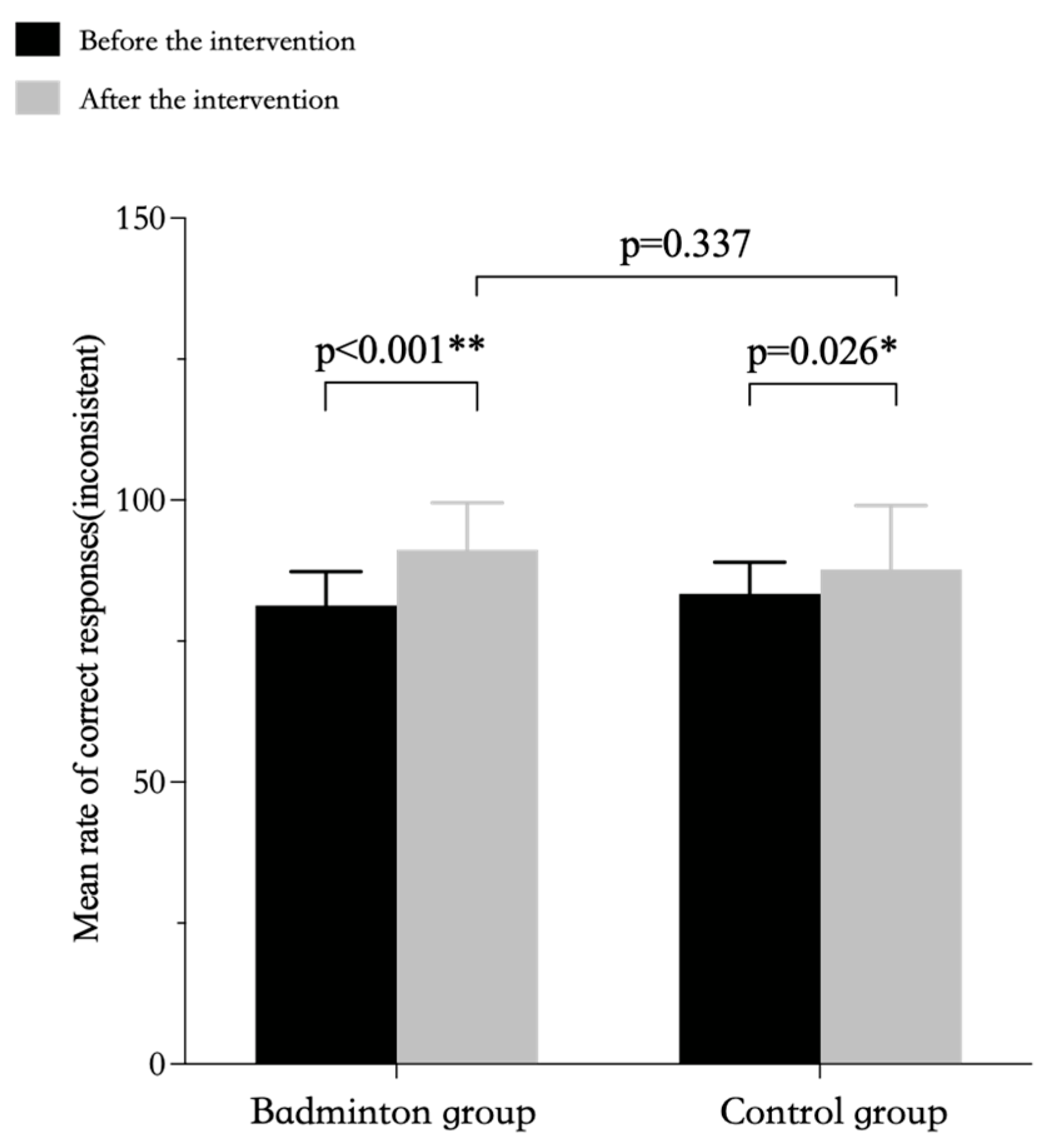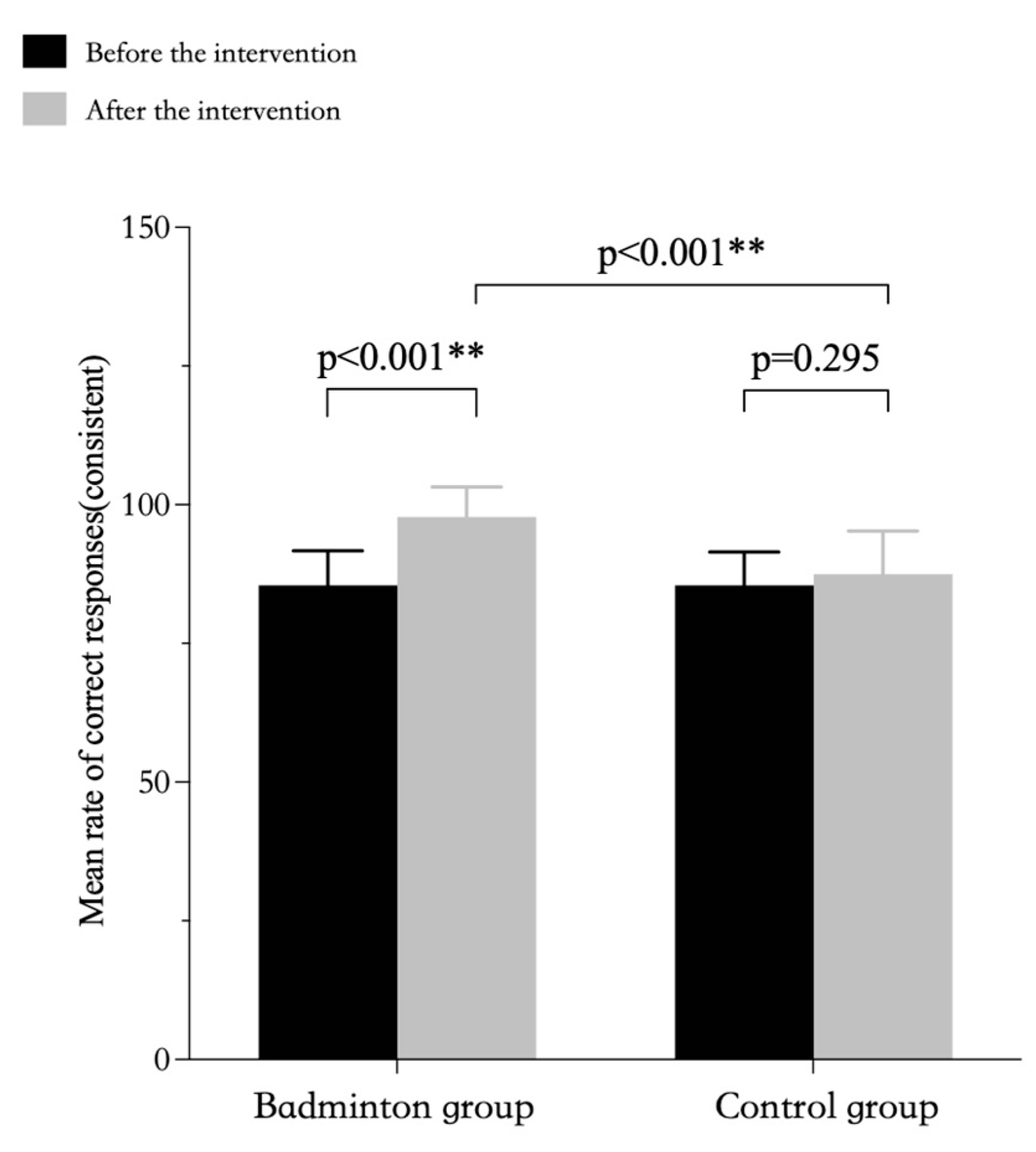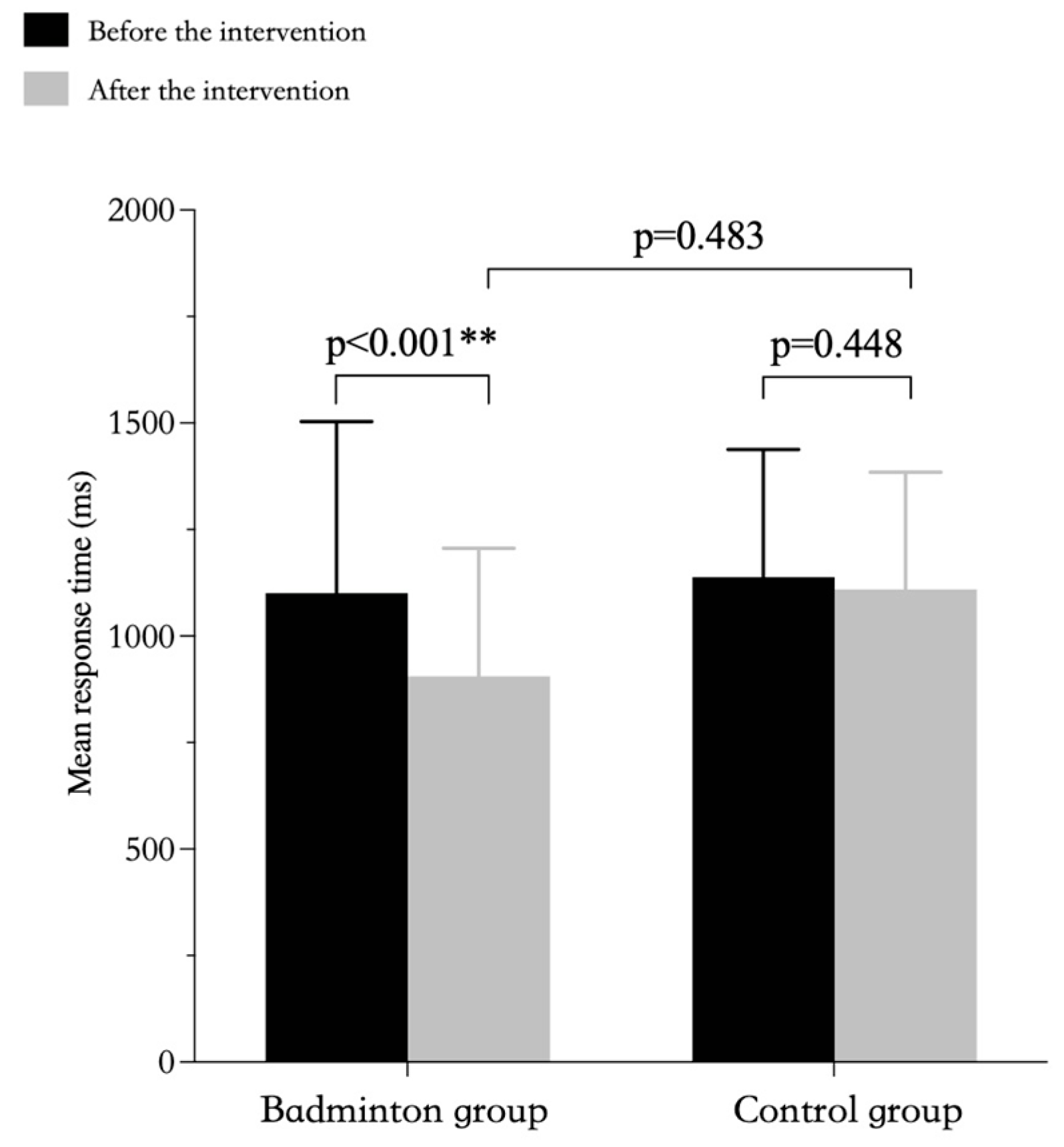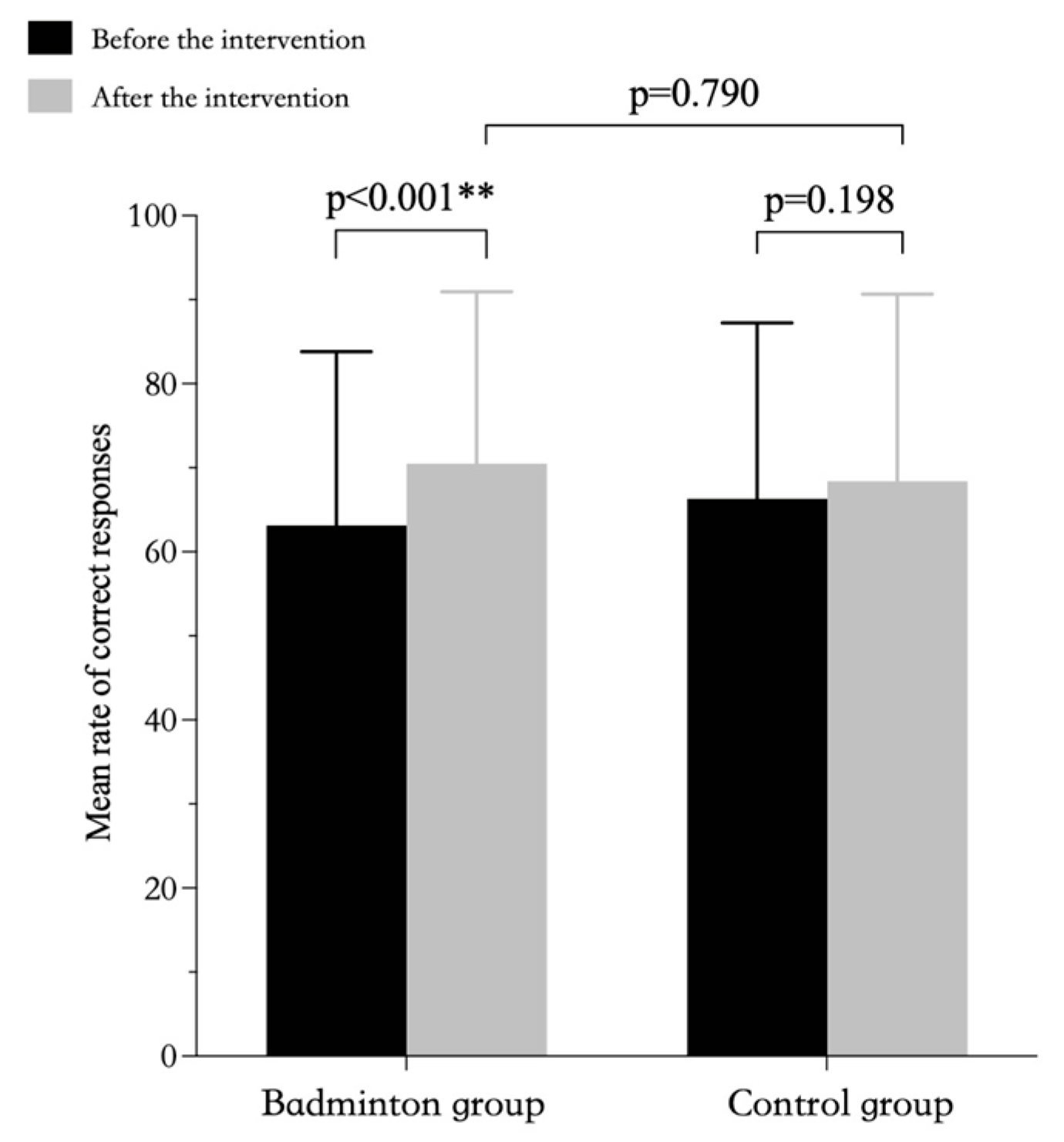Badminton Improves Executive Function in Adults Living with Mild Intellectual Disability
Abstract
1. Introduction
2. Materials and Methods
2.1. Participants
2.2. Experimental Design and Measurements
2.2.1. Badminton Intervention Program Development and Content
2.2.2. Measurement of Executive Function
2.3. Statistical Analysis
3. Results
3.1. Differences in Executive Function between the Badminton and Control Groups before Badminton Intervention
3.2. Differences in Executive Function before vs. after Badminton Intervention
3.2.1. Inhibitory Control
3.2.2. Working Memory
3.2.3. Cognitive Flexibility
4. Discussion
4.1. Effects of Badminton on Inhibitory Control among Adults with Mild Intellectual Disability
4.2. Effects of Badminton on Working Memory among Adults with a Mild Intellectual Disability
4.3. Effects of Badminton on Cognitive Flexibility among Adults with a Mild Intellectual Disability
5. Conclusions
6. Limitations
7. Contribution to the Field
Author Contributions
Funding
Institutional Review Board Statement
Informed Consent Statement
Data Availability Statement
Acknowledgments
Conflicts of Interest
References
- Funahashi, S. Neuronal mechanisms of executive control by the prefrontal cortex. Neurosci. Res. 2001, 39, 147–165. [Google Scholar] [CrossRef]
- Diamond, A. Executive Functions. Annu. Rev. Psychol. 2013, 64, 135–168. [Google Scholar] [CrossRef] [PubMed]
- Miyake, A.; Friedman, N.P.; Emerson, M.J.; Witzki, A.H.; Howerter, A.; Wager, T.D. The Unity and Diversity of Executive Functions and Their Contributions to Complex “Frontal Lobe” Tasks: A Latent Variable Analysis. Cogn. Psychol. 2000, 41, 49–100. [Google Scholar] [CrossRef]
- Lehto, J.E.; Juujärvi, P.; Kooistra, L.; Pulkkinen, L. Dimensions of executive functioning: Evidence from children. Br. J. Dev. Psychol. 2011, 21, 59–80. [Google Scholar] [CrossRef]
- Chen, T.; Li, D. The potential variable analysis of executive function separability and its relationship with age. Acta Psychol. Sin. 2005, 37, 210–217. Available online: https://xueshu.baidu.com/usercenter/paper/show?paperid=c4214b65e1e6d187326a8cad50447bd6&site=xueshu_se (accessed on 12 January 2022).
- Hughes, C.; Ensor, R.; Wilson, A.; Graham, A. Tracking Executive Function Across the Transition to School: A Latent Variable Approach. Dev. Neuropsychol. 2009, 35, 20–36. [Google Scholar] [CrossRef]
- Costanzo, F.; Varuzza, C.; Menghini, D.; Addona, F.; Gianesini, T.; Vicari, S. Executive functions in intellectual disabilities: A comparison between Williams syndrome and Down syndrome. Res. Dev. Disabil. 2013, 34, 1770–1780. [Google Scholar] [CrossRef]
- Pu, Y. Dictionary of Special Education, 3rd ed.; Huaxia Publishing House: Beijing, China, 2014; Available online: https://xueshu.baidu.com/usercenter/paper/show?paperid=e009e31ad0fdefbe0676cc806abc3323&site=xueshu_se (accessed on 12 January 2022).
- Xue, D. The evolution of the definition of Intellectual Disability in the United States and its Enlightenment. Chin. J. Spec. Educ. 2011, 5, 6. Available online: https://xueshu.baidu.com/usercenter/paper/show?paperid=eeeaea2421e33059ea9c8b2fd965665f&site=xueshu_se&hitarticle=1 (accessed on 12 January 2022).
- Tan, J.; Jiang, L.; Ma, X.; Li, S. Advances and Challenges in MRI research of children with mental retardation. Int. J. Med. Radiol. 2020, 43, 4. [Google Scholar] [CrossRef]
- Soto-Ares, G.; Joyes, B.; Lemaitre, M.-P.; Vallée, L.; Pruvo, J.-P. MRI in children with mental retardation. Pediatr. Radiol. 2003, 33, 334–345. [Google Scholar] [CrossRef] [PubMed]
- Decobert, F.; Grabar, S.; Merzoug, V.; Kalifa, G.; Ponsot, G.; Adamsbaum, C.; Portes, V.D. Unexplained mental retardation: Is brain MRI useful? Pediatr. Radiol. 2005, 35, 587–596. [Google Scholar] [CrossRef] [PubMed]
- Da Rocha, A.F.; Leite, C.D.C.; Rocha, F.T.; Massad, E.; Cerri, G.G.; Angelotti, S.A.D.O.; Gomes, E.H.G.; Oliveira, C.C.M. Mental retadation: A MRI study of 146 Brazilian children. Arquivos de Neuro-Psiquiatria 2006, 64, 186–192. [Google Scholar] [CrossRef] [PubMed]
- Chevalère, J.; Postal, V.; Jauregui, J.; Copet, P.; Laurier, V.; Thuilleaux, D. Executive Functions and Prader-Willi Syndrome: Global Deficit Linked with Intellectual Level and Syndrome-Specific Associations. Am. J. Intellect. Dev. Disabil. 2015, 120, 215–229. [Google Scholar] [CrossRef]
- Frost, N.; Weinborn, M.; Gignac, G.; Markovic, S.; Rainey-Smith, S.R.; Sohrabi, H.R.; Martins, R.; Peiffer, J.; Brown, B.M.; Castalanelli, N. Higher Cardiorespiratory Fitness Is Associated with Better Verbal Generativity in Community-Dwelling Older Adults. J. Aging Phys. Act. 2019, 27, 703–710. [Google Scholar] [CrossRef] [PubMed]
- Li, Y. The Relationship between Physical Fitness, Executive Function and Default Mode Network in College Students. Master’s Thesis, Yangzhou University, Yangzhou, China, 2020. [Google Scholar] [CrossRef]
- Sung, M.-C.; Ku, B.; Leung, W.; MacDonald, M. The Effect of Physical Activity Interventions on Executive Function Among People with Neurodevelopmental Disorders: A Meta-Analysis. J. Autism Dev. Disord. 2022, 52, 1030–1050. [Google Scholar] [CrossRef] [PubMed]
- Wuang, Y.-P.; Tsai, H.-Y.; Wang, C.-C.; Chen, M.-D. The effectiveness of racket-sport intervention on visual perception and executive functions in children with mild intellectual disabilities and borderline intellectual functioning. Neuropsychiatr. Dis. Treat. 2015, 11, 2287–2297. [Google Scholar] [CrossRef] [PubMed]
- Chen, W. A Comparative Study on Executive Function of Athletes in Different Sports. Master’s Thesis, East China Normal University, Shanghai, China, 2012. Available online: https://kns.cnki.net/kcms/detail/detail.aspx?dbcode=CMFD&dbname=CMFD201401&filename=1012439801.nh&uniplatform=NZKPT&v=cPZo-d-O3lO3SVGifCDsnQPAJj2A0qR20HdLEDI--AESteLlytfJc_SfA4wgD6bk (accessed on 12 January 2022).
- Yu, Q.; Chan, C.C.; Chau, B.; Fu, A.S. Motor skill experience modulates executive control for task switching. Acta Psychol. 2017, 180, 88–97. [Google Scholar] [CrossRef] [PubMed]
- Song, Z.; Fu, Q. Study on the Influence of Sports Intervention on Adolescents’ Executive Function Based on Motor Skill Classification. Contemp. Sport. Sci. Technol. 2018, 8, 3. Available online: https://xueshu.baidu.com/usercenter/paper/show?paperid=9134dcd230ef5ae5414d8579e1759776&site=xueshu_se (accessed on 12 January 2022).
- Pan, J.; Yin, H.; Chen, A.; Cui, L.; Yuan, W.; Cui , Y. An experimental study on the effect of exercise intervention on Executive Function of primary school students with learning difficulties and normal students. Sport. Sci. 2016, 36, 9. [Google Scholar] [CrossRef]
- Oh Hae, M.; Cho, H.; Youn, S.; Jeon, C.; Seo, G.; Su, Y.; Hee, J. The Effect of Badminton Exercise Program on Body Composition and Physical Fitness of Children with Intellectual Disabilities. J. Motologie 2015, 1, 105–128. Available online: https://www.webofscience.com/wos/alldb/full-record/KJD:ART002679574 (accessed on 12 January 2022).
- Yu, Q.; Zhao, H. The effect of different durations of badminton exercise on executive function of smoking addicts: Evidence from behavioral and ERP studies. The 23rd national conference on psychology based (under), Chinese Psychological Society, China. 2021, pp. 173–174. Available online: https://kns.cnki.net/kcms2/article/abstract?v=3uoqIhG8C467SBiOvrai6TdxYiSzCnOEEIKB-6S51JyFOld47yB1sEYudiLmvrnT38U7rhYesjEmdYN2hT22nDB7O1Ul4uS_V-U7ZfgNoS0%3d&uniplatform=NZKPT (accessed on 12 January 2022).
- Vostrý, M.; Lanková, B.; Pešatová, I.; Fleischmann, O.; Jelínková, J. Nonpharmacological Compensation of Aggressive Behavior of Individuals with Moderate Intellectual Disability and Behavioral Disorders—A Case Study. Int. J. Environ. Res. Public Health 2022, 19, 9116. [Google Scholar] [CrossRef]
- Vostrý, M.; Lanková, B.; Zilcher, L.; Jelinková, J. The Effect of Individual Combination Therapy on Children with Motor Deficits from the Perspective of Comprehensive Rehabilitation. Appl. Sci. 2022, 12, 4270. [Google Scholar] [CrossRef]
- Yang, H. An Experimental Study on the Influence of Different Sports Training on the Executive Function of Junior High School Students. Master’s Thesis, Nanjing Normal University, Nanjing, China, 2017. Available online: https://kns.cnki.net/kcms/detail/detail.aspx?dbcode=CMFD&dbname=CMFD201801&filename=1017285431.nh&uniplatform=NZKPT&v=LYq0vyWObYTLpXZBWQu6fui8-xeBr5AUjZ3xzMXtjHqWpwFpnebhUiiVzn40RNV2 (accessed on 12 January 2022).
- Su, W. The Impact of Badminton on the Executive Function of Primary School Students. Master’s Thesis, Shanghai Institute of Physical Education, Shanghai, China, 2021. [Google Scholar] [CrossRef]
- Liu, L.; Jiang, Q. A Study on the inhibition and Control Development of Students with Intellectual Disabilities in Mental schools. China Spec. Educ. 2014, 7, 19–25. Available online: https://kns.cnki.net/kcms/detail/detail.aspx?dbcode=CJFD&dbname=CJFD2014&filename=ZDTJ201407005&uniplatform=NZKPT&v=4fTNYyBYpoOaIWPlan6HDc6jax1tkgX19WoNFgiCGGe-4o7h22qa4cGwZgB7EZjq (accessed on 12 January 2022).
- Ji, X. Research on the Difference of Executive Function of Primary School Students Trained by Different Sports. Master’s Thesis, Yangzhou University, Yangzhou, China, 2014. Available online: https://kns.cnki.net/kcms/detail/detail.aspx?dbcode=CMFD&dbname=CMFD201501&filename=1014359601.nh&uniplatform=NZKPT&v=SQVCzRH-eU4H_B-NI_1OJOMzObm5OdEcHVOZRuLPS6kB3WV-EVnHUTF08S8jK0Yc (accessed on 12 January 2022).
- Kamijo, K.; Takeda, Y. Regular physical activity improves executive function during task switching in young adults. Int. J. Psychophysiol. 2010, 75, 304–311. [Google Scholar] [CrossRef] [PubMed]
- Dai, C.-T.; Chang, Y.-K.; Huang, C.-J.; Hung, T.-M. Exercise mode and executive function in older adults: An ERP study of task-switching. Brain Cogn. 2013, 83, 153–162. [Google Scholar] [CrossRef]
- Chen, A.; Zhao, L.; Li, H.; Yan, J.; Yin, H. The effect of Different intensity Short time basketball dribbling Training on the Executive function of Primary school students. J. Tianjin Inst. Phys. Educ. 2014, 29, 352–355. Available online: https://kns.cnki.net/kcms2/article/abstract?v=3uoqIhG8C44YLTlOAiTRKibYlV5Vjs7ir5D84hng_y4D11vwp0rrtfED_PGkgeVlFg3fQdkrZTXAdM1EToKCC5kT6qdjW1Q8&uniplatform=NZKPT (accessed on 12 January 2022).
- Wen, P.; Li, H. The Development of Executive Function in children aged 6-11 years. Psychol. Insights 2007, 27, 6. [Google Scholar] [CrossRef]
- Zhu, H. Effects of Aerobic Fitness Training on Inhibition Control and White Matter Integrity of College Students. Master’s Thesis, Yangzhou University, Yangzhou, China, 2021. [Google Scholar] [CrossRef]
- Wang, S. The Influence of Different Exercise Styles on Inhibition Control of College Students. Master’s Thesis, Jiangxi Normal University, Nanchang, China, 2021. [Google Scholar] [CrossRef]
- Bai, X.; Shao, M.; Liu, T.; Yin, J.; Jin, H. Badminton reshapes brain gray and white matter structure in early adulthood. Acta Psychol. Sin. 2020, 52, 173–183. [Google Scholar] [CrossRef]
- Guo, X. The effect of 8-week Badminton Skills Practice and Stop Practice on Executive Function of junior Middle School students. In Proceedings of the 12th Session of National Sports Science Conference Paper Based Assembly Chinese Society of Sports Science, Rizhao, China, 25 March 2022; pp. 325–326. Available online: https://kns.cnki.net/kcms2/article/abstract?v=3uoqIhG8C467SBiOvrai6TdxYiSzCnOET0Xr_I8pgMuCFSD7JyYj-mR5D-wNrhScUXWmSM383eacqNLlNyyMhGvKZvLFB2GQ2r1F1BkeOcU%3d&uniplatform=NZKPT (accessed on 12 January 2022).
- Aadland, K.N.; Moe, V.F.; Aadland, E.; Anderssen, S.A.; Resaland, G.K.; Ommundsen, Y. Relationships between physical activity, sedentary time, aerobic fitness, motor skills and executive function and academic performance in children. Ment. Health Phys. Act. 2017, 12, 10–18. [Google Scholar] [CrossRef]
- Chen, A.; Zhu, L.; Ji, X. Differences in Executive function of primary school students trained in different sports. In Proceedings of the 2015 International Conference on Education Research and Reform (ERR), 2015 V9 ed.; Singapore Management and Sports Science Institute: Singapore, 2015; pp. 691–694. Available online: https://kns.cnki.net/kcms/detail/detail.aspx?dbcode=IPFD&dbname=IPFDLAST2016&filename=ZNXX201504002124&uniplatform=NZKPT&v=oU4QzGpFstfKcDrf3tt0cVAcZjklbDR5jPPvIweRK4aEt9H3aRBv-XP6TVVKX5q-9bQ7qizHukA%3d (accessed on 12 January 2022).
- Yu, Q.; Zhao, H.; Gao, H.; Qi, H. Effects of acute badminton exercise on executive function in smoking addicts: Evidence from behavioral and ERP studies. In Proceedings of the 12th Session of National Sports Science Conference Paper Based Assembly Chinese Society of Sports Science, Rizhao, China, 25 March 2022; pp. 319–320. [Google Scholar] [CrossRef]




| Group | Sex | Age, y Mean (SD) | Height, cm Mean (SD) | Weight, kg Mean (SD) | BMI Mean (SD) |
|---|---|---|---|---|---|
| Badminton (n = 15) | Men (n = 10) | 36.00 (3.64) | 168.53 (9.23) | 70.51 (12.98) | 24.87 (4.52) |
| Women (n = 5) | |||||
| Sig | 0.486 | 0.378 | 0.467 | 0.378 | |
| Control (n = 15) | Men (n = 10) | 35.60 (4.32) | 170.83 (11.46) | 73.98 (15.26) | 25.24 (3.84) |
| Women (n = 5) | |||||
| Sig | 0.371 | 0.161 | 0.233 | 0.387 | |
| Total | 35.80 (3.93) | 168.68 (10.29) | 72.25 (14.25) | 25.05 (4.12) |
| Training Content | Time | Strength | |
|---|---|---|---|
| Warm up | Warm-up exercises, mobile warm-up exercises, and jogging | 10 min | Low and medium |
| Training | Badminton skills practice | 40 min | Medium and high |
| 1–3 weeks | Forehand grip, forehand grip, forehand serve, backhand grip, and backhand serve | Swing 10 min | |
| With the shuttlecock 20 min | |||
| Quality training: badminton special footwork, plank support, and static squat | Quality 10 min | ||
| 4–6 weeks | High shuttlecock technique (place swing, jump swing, and moving swing) | Swing 10 min | |
| With the shuttlecock 20 min | |||
| Quality training: a variety of jumping, crawling exercises, and heel exercises | Quality 10 min | ||
| 7–9 weeks | Net in situ and mobile net technique and shuttlecock picking technique | Swing 10 min | |
| With the shuttlecock 20 min | |||
| Game 10 min | |||
| Quality training: running 1000 m and standing on one foot with their eyes closed | Quality 10 min | ||
| 10–12 weeks | Using a technique before catching a high shuttlecock (moving footwork practice); game practice | Swing 10 min | |
| With the shuttlecock 20 min | |||
| Game 10 min | |||
| Quality training: full command footwork, push-ups and full squats | Quality 10 min | ||
| Cool down | Static stretching | 10 min | Low |
| Executive Function | Test Condition | Badminton (n = 15) | Control (n = 15) | t | p |
|---|---|---|---|---|---|
| Stroop test | Response time (ms) | ||||
| Inconsistent | 712.42 (163.15) | 740.12 (132.83) | 0.51 | 0.614 | |
| Consistent | 695.04 (172.77) | 723.60 (156.39) | −0.475 | 0.639 | |
| Inhibitory control ability | −28.35 (85.05) | −23.48 (198.10) | 0.088 | 0.931 | |
| Accuracy (% correct) | |||||
| Inconsistent | 81.33 (6.01) | 83.38 (5.62) | −0.964 | 0.343 | |
| Consistent | 85.48 (6.20) | 85.48 (6.02) | 0.209 | 0.836 | |
| 1-Back test | Response time (ms) | ||||
| 1100.84 (402.60) | 1138.58 (299.18) | −0.998 | 0.335 | ||
| Accuracy (% correct) | |||||
| 63.13 (20.67) | 66.32 (20.92) | −1.279 | 0.222 | ||
| Task switching | Response time (ms) | ||||
| Trails requiring no task switching | 1152.44 (181.10) | 1127.04 (200.76) | 0.364 | 0.719 | |
| Trials requiring task switching | 1429.03 (284.20) | 1483.10 (322.77) | 0.487 | 0.630 | |
| Cognitive flexibility ability | 276.60 (152.81) | 356.05 (184.96) | −1.283 | 0.210 | |
| Accuracy (% correct) | |||||
| Trails requiring no task switching | 85.72 (11.76) | 81.25 (13.78) | 0.955 | 0.348 | |
| Trials requiring task switching | 73.77 (19.52) | 71.67 (17.19) | 0.350 | 0.732 | |
| Executive Function | Stroop Test | Badminton (n = 15) | Control (n = 15) | Time Effect | Group Effect | Interaction | ||
|---|---|---|---|---|---|---|---|---|
| Before Intervention Mean (SD) | After Intervention Mean (SD) | Before Intervention Mean (SD) | After Intervention Mean (SD) | |||||
| Inhibitory control | Response time, inconsistent (ms) | 712.42 (163.15) | 618.57 (140.30) | 740.12 (132.83) | 704.12 (159.78) | 0.002 ** | 0.278 | 0.137 |
| Response time, consistent (ms) | 695.04 (172.77) | 628.38 (153.84) | 723.60 (156.39) | 701.08 (157.45) | 0.024 * | 0.369 | 0.247 | |
| Response time. inconsistent/consistent | −28.35 (85.05) | −9.81 (90.54) | −23.48 (198.10) | 3.03 (134.24) | 0.433 | 0.827 | 0.889 | |
| Accuracy, inconsistent, (%) correct | 81.33 (6.01) | 91.22 (8.28) | 83.38 (5.62) | 87.67 (11.39) | 0.000 ** | 0.782 | 0.039 * | |
| Accuracy, consistent, (%) correct | 85.48 (6.20) | 97.81 (5.37) | 85.48 (6.02) | 87.48 (7.77) | 0.000 ** | 0.021 * | 0.000 ** | |
| Indicators | Sources of Variation | F | p | η2 |
|---|---|---|---|---|
| Stroop test accuracy, inconsistent | Time within group 1 | 29.347 | 0.000 ** | 0.512 |
| Time within group 2 | 5.512 | 0.026 * | 0.164 | |
| Group within time (2) | 0.953 | 0.337 | 0.033 | |
| Stroop test accuracy, consistent | Time within group 1 | 79.494 | 0.000 ** | 0.740 |
| Time within group 2 | 1.141 | 0.295 | 0.039 | |
| Group within time (2) | 19.627 | 0.000 ** | 0.412 |
| Executive Function | 1-Back Test | Badminton (n = 15) | Control (n = 15) | Time Effect | Group Effect | Interaction | ||
|---|---|---|---|---|---|---|---|---|
| Before Intervention Mean (SD) | After Intervention Mean (SD) | Before Intervention Mean (SD) | After Intervention Mean (SD) | |||||
| Working memory | Response time, ms | 1100.84 (402.60) | 905.70 (299.98) | 1138.58 (299.18) | 1109.24 (275.37) | 0.001 ** | 0.488 | 0.001 ** |
| Accuracy, % correct | 63.13 (20.67) | 70.50 (20.44) | 66.32 (20.92) | 68.40 (22.26) | 0.001 ** | 0.944 | 0.025 * | |
| Indicators | Sources of Variation | F | p | η2 |
|---|---|---|---|---|
| 1-back test response | time within group 1 | 26.185 | 0.000 ** | 0.483 |
| time within group 2 | 0.592 | 0.448 | 0.021 | |
| Group within time (2) | 3.748 | 0.063 | 0.118 | |
| 1-back test accuracy | time within group 1 | 21.701 | 0.000 ** | 0.437 |
| time within group 2 | 1.736 | 0.198 | 0.058 | |
| Group within time (2) | 0.072 | 0.790 | 0.003 |
| Executive Function | Task switching Test | Badminton (n = 15) | Control (n = 15) | Time Effect | Group Effect | Interaction | ||
|---|---|---|---|---|---|---|---|---|
| Before Intervention Mean (SD) | After Intervention Mean (SD) | Before Intervention Mean (SD) | After Intervention Mean (SD) | |||||
| Cognitive flexibility | Response time (trails requiring no task switching), ms | 1152.44 (181.10) | 1002.51 (150.50) | 1127.04 (200.76) | 1140.37 (493.35) | 0.168 | 0.558 | 0.102 |
| Response time (trials requiring task switching), ms | 1429.03 (284.20) | 1316.09 (247.07) | 1483.10 (322.77) | 1428.94 (317.61) | 0.003 ** | 0.431 | 0.264 | |
| Response time (trials requiring task switching—trails requiring no task switching), ms | 276.60 (152.81) | 313.58 (179.53) | 356.05 (184.96) | 288.57 (415.21) | 0.759 | 0.734 | 0.298 | |
| Accuracy (trails requiring no task switching), % correct | 85.72 (11.76) | 89.70 (8.31) | 81.25 (13.78) | 82.01 (16.72) | 0.221 | 0.174 | 0.400 | |
| Accuracy (trials requiring task switching), % correct | 73.77 (19.52) | 83.30 (11.97) | 71.67 (17.19) | 77.20 (18.02) | 0.033 * | 0.435 | 0.557 | |
Disclaimer/Publisher’s Note: The statements, opinions and data contained in all publications are solely those of the individual author(s) and contributor(s) and not of MDPI and/or the editor(s). MDPI and/or the editor(s) disclaim responsibility for any injury to people or property resulting from any ideas, methods, instructions or products referred to in the content. |
© 2023 by the authors. Licensee MDPI, Basel, Switzerland. This article is an open access article distributed under the terms and conditions of the Creative Commons Attribution (CC BY) license (https://creativecommons.org/licenses/by/4.0/).
Share and Cite
Wang, Y.; Wu, X.; Chen, H. Badminton Improves Executive Function in Adults Living with Mild Intellectual Disability. Int. J. Environ. Res. Public Health 2023, 20, 3673. https://doi.org/10.3390/ijerph20043673
Wang Y, Wu X, Chen H. Badminton Improves Executive Function in Adults Living with Mild Intellectual Disability. International Journal of Environmental Research and Public Health. 2023; 20(4):3673. https://doi.org/10.3390/ijerph20043673
Chicago/Turabian StyleWang, Yifan, Xueping Wu, and Huawei Chen. 2023. "Badminton Improves Executive Function in Adults Living with Mild Intellectual Disability" International Journal of Environmental Research and Public Health 20, no. 4: 3673. https://doi.org/10.3390/ijerph20043673
APA StyleWang, Y., Wu, X., & Chen, H. (2023). Badminton Improves Executive Function in Adults Living with Mild Intellectual Disability. International Journal of Environmental Research and Public Health, 20(4), 3673. https://doi.org/10.3390/ijerph20043673





